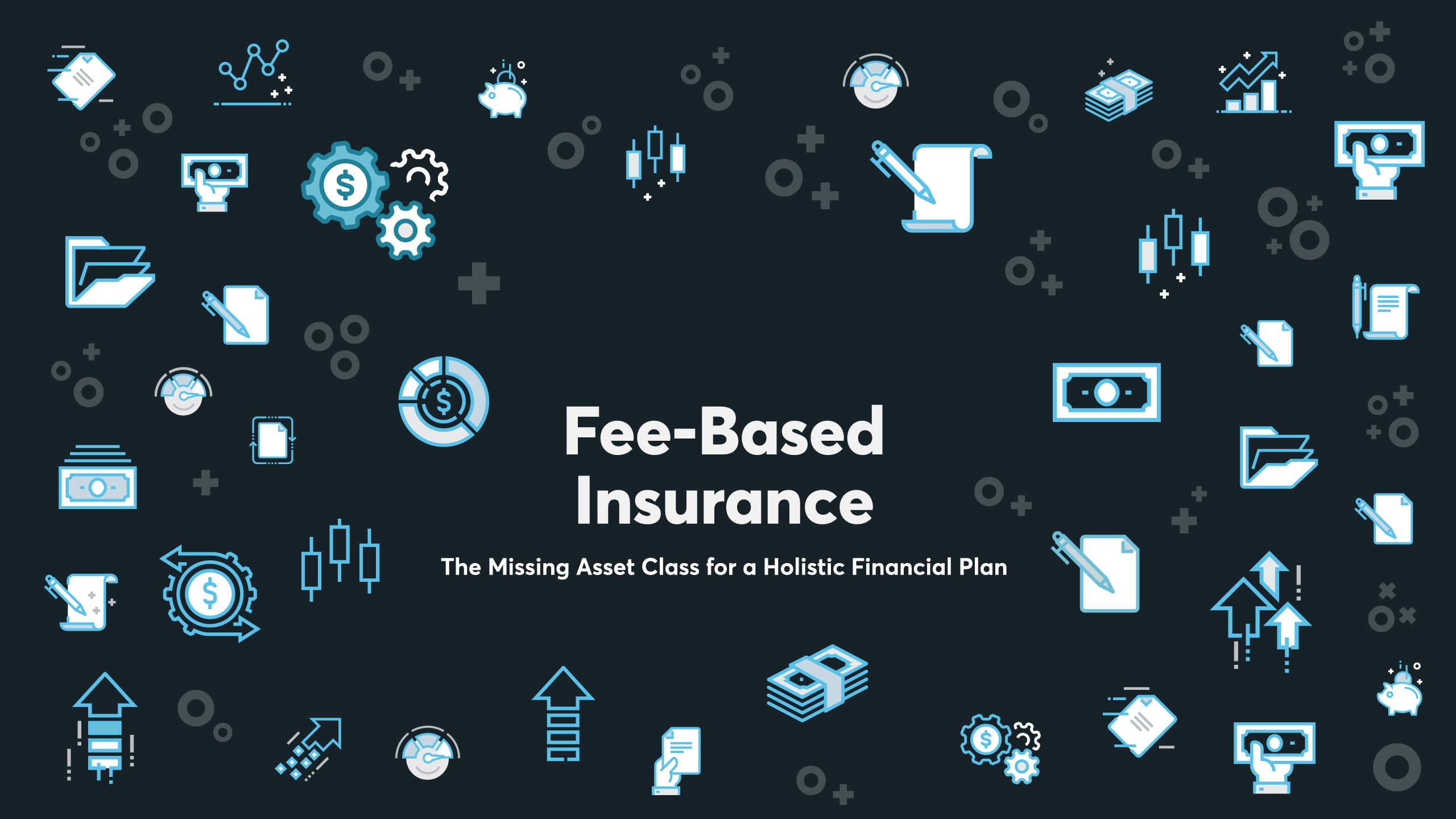

Until recently, Registered Investment Advisors (RIAs) and fee-based advisors have had reasons not to incorporate insurance and annuity products into their clients’ financial plans. Many traditional insurance and annuity products have layers of asset-based fees, complex features, and may have fewer investment options. What’s more, these products have generally been commission-based and their use restricted to those with insurance licenses.
Times have changed. A new category of insurance, without commissions and developed to fit the fee-based distribution model, has become more widely available in the last few years. This is allowing RIAs and fee-based advisors to incorporate insurance in ways they had never considered—as a tax management tool for clients, as a boon to clients’ retirement planning, and as a way to manage clients’ legacy planning and charitable giving.
For independent RIAs and fee-based advisors, this new category of fee-based insurance products brings with it a rare chance to consolidate “held-away” assets. That could mean more fee-based AUM for advisors. This can also allow for a more holistic approach to planning that some of the most successful advisors use—and that is only possible when all of a client’s assets are consolidated within a single portfolio.
To be sure, RIAs and fee-based advisors still have some work to do to incorporate fee-based insurance products into their practices. They must find insurance partners who understand the unique needs of the independent fee-based channel, educate themselves on the options, and work through some knotty administrative issues such as how to assess the level of fees or charges for investment advice related to insurance products. But in a world where advisors are increasingly facing questions about what they do that’s indispensable, the skillful use of fee-based insurance products within an advisor’s practice can be an important differentiator.

The business of providing financial advice has changed dramatically. Twenty years ago, it was enough to have an understanding of the stock and bond markets and a knack for relationship-building; with those attributes, you could make a good living as a broker.
But fee-based advice has been on the rise, as more advisors choose to focus on growing assets for their clients as a way to grow their firm’s earnings instead of the constant pressure to focus on sales and transactions to generate revenue. The commission model has also declined as clients have become aware of the potential for conflicts of interest. Financial regulators have accelerated the shift by raising the possibility of stiff fines for advisors who fail to act as fiduciaries.

Seventy-eight percent of all advisors are now fee-based, meaning they earn more than half of their revenue from advisory fees, according to Cerulli Associates. That’s up from 46% in 2003. By 2021, the number of Registered Investment Advisors and other fee-based advisors will grow by another 10%, the research firm says, and they will have 20% more of the available client assets under management.
At the same time that more advisors are adopting an independent fee-based or fee-only model, other factors are shaping the way advisors manage their practice and serve their clients. Technology is one of the biggest. Software algorithms are increasingly being used for some fundamental advisor services such as asset allocation, and technology in general has begun to disintermediate the business. Today, a growing number of younger prospective clients are digital natives, used to doing things with the help of smartphone apps or other technologies. Many of them see no reason why this wouldn’t extend to financial services, too.
Advisors must provide clear value if they are to justify their fees. In this new world, many advisors are starting to offer holistic planning. With holistic planning, advisors go beyond the basic asset allocation and portfolio management that have traditionally been their bread and butter. They get into risk management and principal protection, tax-advantaged investing and tax planning, and estate planning and legacy planning. This allows them to play a broader role in their clients’ financial lives and reduces the likelihood of a simplistic one-to-one comparison of their value to that of a robo-advisor. But it requires advisors to develop capabilities in new areas and to be resourceful in finding services that differentiate them.

As they look to increase the value of what they do for clients, RIAs and fee-based advisors shouldn’t overlook insurance products. Insurance is the only financial product that can provide a guaranteed income stream, increasingly important at a time when concerns about Social Security are on the rise and corporate pension plans are on the decline. Insurance can also provide tax advantages for clients when they are accumulating wealth, generating retirement income, and transferring wealth to heirs.
The fact that many RIAs and fee-based advisors don’t integrate insurance within their clients’ financial plans, in spite of these benefits, isn’t surprising. Most of the traditional insurance that makes sense for investors—including annuities, with their guaranteed income streams—are commission-based products that can only be sold by someone appointed as a licensed agent of the insurance company. This doesn’t fit with the model of fee-based and fee-only advice, and trying to persuade a client to use an annuity could be awkward, raising old questions about potential conflicts of interest.
In addition, most traditional insurance products don’t include data feeds that work with the custodial platforms and portfolio management systems used by independent RIAs and fee-based advisors. Without this type of technical integration, the addition of insurance to a portfolio would add complexity to the advisor’s job and create a less-than-optimal experience for the client. There are other reasons why RIAs and fee-based advisors hesitate to consider traditional insurance, many of them rooted in its complexity, not just from the client’s perspective but also from the advisor’s.
The good news is that insurance products are beginning to change. In the last few years, a new category of fee-based insurance products has emerged that eliminates commissions and the corresponding contingent deferred sales charge, which can lock in clients and penalize them should they need to access their assets. Fee-based insurance also offers more choice, takes a step toward simplicity and transparency, and provides better integration with existing technology platforms.
For advisors who have been transitioning toward a fee-based model by adopting no-load mutual funds, no-fee ETFs, and low-cost stock trades, insurance is one area where they have not been able to make the transition until the advent of fee-based insurance. For RIAs and fee-based advisors who have avoided traditional insurance altogether, fee-based insurance is akin to a new asset class for them—a new solution to help clients manage risk, or even eliminate certain risks, and potentially pursue higher returns.
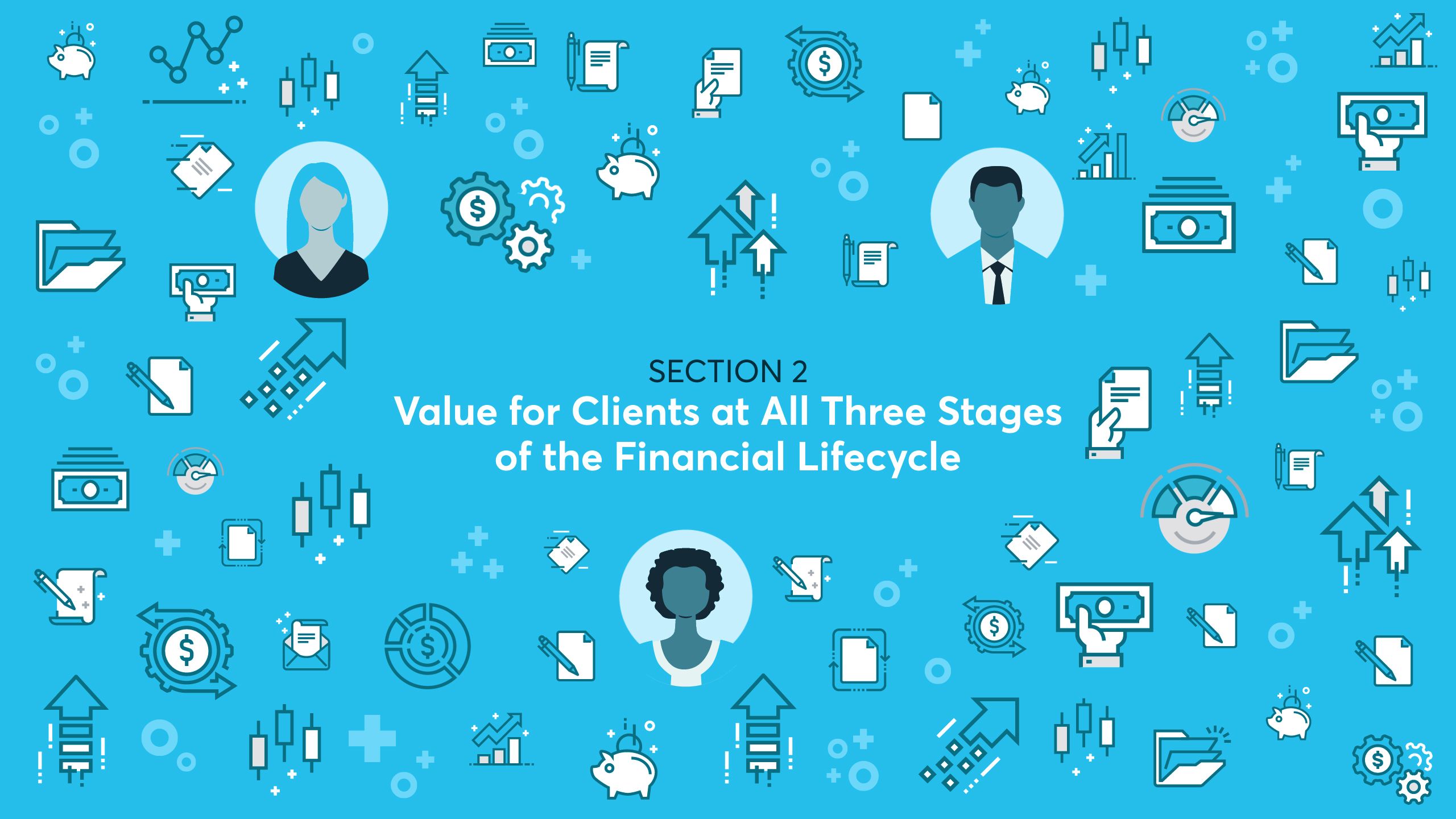
The average client of an RIA has more than $2 million in assets under management, according to a 2018 study by Charles Schwab. Such a client typically has three financial goals: to accumulate wealth, to maintain his or her lifestyle in retirement, and to leave a legacy, whether to family members or philanthropic organizations. Insurance, in the right form, can help with all of these.

For high earners with income above $500,000 per year, and high net worth individuals having $1 million or more in investable assets, taxes are among the biggest obstacles to accumulating wealth. Taxes can easily eat up 40% of an affluent person’s investment gains each year, when federal and state taxes are factored in.
Tax-deferred investment vehicles, such as 401(k)s and IRAs, have long been used to mitigate this impact. But because the contribution limits are relatively low ($19,000 per year for a 401(k) and $6,000 for an IRA as of 2019, not including catch-up provisions for those over 50), these “qualified” accounts can only shield a small amount of what high earners and high net worth individuals bring in.
Insurance products such as Investment-Only Variable Annuities and Variable Universal Life (discussed in more detail in the next section) offer the potential for unlimited tax deferred contributions—meaning there are virtually no restrictions on the amount invested. And clients can continue investing after age 70 ½—not generally allowed with qualified accounts. In addition, unlike qualified plans and IRAs, these insurance products have no minimum distribution requirements during the life of the owner.
Moreover, a savvy investor could use her insurance and annuity contracts as vehicles to hold tax-inefficient assets—including fixed-income, commodities, REITs, liquid alternatives, and other actively traded funds—because the gains from those investments would not be taxable until they are distributed from the contract. In doing so, she could compound the earnings on these assets and accumulate more wealth while paying no taxes during the deferral period.
Another advantage of using certain insurance products in the accumulation phase—when done skillfully—is downside protection in a volatile market. Fixed annuities, fixed indexed annuities, and index-linked variable annuities (also discussed in the next section) can provide both income guarantees and downside protection from losses should the underlying assets lose value. And of course, an investor who has protection in one part of a portfolio can use riskier assets elsewhere in pursuit of higher returns.

Using a specialized annuity to reduce taxable income
As a partner at a consulting company, Kate, 37, was earning a substantial salary and annual bonuses well into the six figures. However, she was concerned by how much in taxes were taken out of her income.
Kate was already maxing out her 401(k) plan and her IRA, but her advisor, Leslie, pointed out that an Investment-Only Variable Annuity (IOVA) could help Kate shelter tens of thousands more in after-tax income. Kate was especially pleased when Leslie showed her the investment options available within the IOVA—literally hundreds of them, many fitting Kate’s profile as a moderately aggressive investor. In the first year that she pursued this strategy, Kate invested $50,000 in her IOVA. Included in her IOVA were some actively traded funds for which Kate could defer taxation on short-term gains until she takes a taxable distribution.

Retirement has arrived for Baby Boomers in the U.S.—10,000 of them are leaving the workforce each day. As they do so, their top concern, according to multiple studies, is outliving their savings.
There are four ways that insurance products can help retiring Boomers lower the risk of income shortfalls. The first, as described above, is by giving individuals a vehicle for additional tax-deferred savings. The more clients accumulate, the more income they can generate in retirement. This can be especially important for individuals who do not have access to employer-sponsored plans, as well as for high earners and high net worth who can easily max-out the contribution limits of their qualified plans.
Second, for those already in retirement, insurance can provide another guaranteed income stream, serving as a complement to Social Security. That is, a retiree can buy an annuity to ensure a steady minimum level of monthly income. In some cases, this can provide more income than a bond- or CD-laddering strategy. With part of a portfolio allocated to a guaranteed income stream, another part can be invested more aggressively for greater growth potential.
Third, insurance can lessen the inherent hazards of drawing down on an investment portfolio, a strategy that exposes the retiree to market downturns and sequence-of-returns risk. Fourth, certain kinds of insurance—such as single premium immediate annuities and variable annuities with income guarantees—can mitigate longevity risk, protecting clients against the risk of outliving their assets.

Using an Annuity to Increase the Level of Guaranteed Income
As she approached 70, Lauren, with $3 million in liquid assets, was planning to retire, but struggled with how to ensure her goal of $150,000 in annual retirement income. On her advisor’s recommendation, she had delayed taking Social Security in order to qualify for the maximum, which in her case came to $44,376 a year. But that still left her about $106,000 short of her retirement income goal.
Using the 4% rule of thumb, Lauren knew that, theoretically, she could withdraw $120,000 from her portfolio and not run out of money for 30 years. But she also knew that the 4% rule doesn’t always pan out—market volatility and unlucky timing can affect the sequence of returns and get in the way. So Lauren decided to hedge her bets. She put $500,000 of her available assets into a fee-based single premium immediate annuity (SPIA) that would guarantee her $31,000 annually. That meant Lauren would only need to withdraw $75,000 a year from her remaining $2.5 million portfolio—a plan that she felt she would be comfortable following even in years when her investments weren’t doing well.

Once clients enter retirement, advisors usually encourage them to take a fresh look at the “who, when, and how much” of their legacy plans for heirs and other inheritors. An enormous amount is at stake. The transfer of wealth between Baby Boomers and their Gen X and Millennial heirs in the coming decades will amount to about $30 trillion, according to industry estimates. And many inheritors of that wealth won’t be inclined to stick with the advisors used by their mothers and fathers; studies show the drop-off rate could be anywhere from 65% to 90%.
In a survey from early 2018 by Nationwide Advisory Solutions, attracting and retaining their clients’ heirs was among the top three concerns for RIAs and fee-based advisors, including the most successful. The use of insurance products can help clients at the legacy and estate planning stage—and can also help advisors turn their clients’ children into new clients.
First, advisors can incorporate insurance into clients’ plans as a way to keep estates, or parts of estates, from getting tangled up in legal proceedings. This is because proceeds for annuities and other insurance products can be structured to be passed directly to beneficiaries without going through probate or a complex legal process. With proper planning, this also may be a way to avoid estate taxes at the federal or state level.
Second, “stretch” provisions for certain annuities can be used to create a lifetime annual income stream for the next generation. This can help eliminate the worry that an heir receiving a single lump-sum payment might squander it—while also helping them avoid the tax burden that would be triggered by a lump-sum payment. Instead, the only amounts that would be taxable each year would be a portion of the annual income stream paid out over the beneficiary’s lifespan. The remaining assets in the annuity can accumulate tax-deferred.
Third, for those clients who want to set up a trust, insurance can allow this to happen in a tax-advantaged fashion. However, for properly structured trusts using an annuity, the income earned can accumulate tax-deferred until it is distributed from the annuity. Consequently, Investment-Only Variable Annuities can be a good investment vehicle for trusts, with their potentially lower fees and broader selection of underlying investment options allowing clients to build diversified portfolios, accumulate assets tax-deferred, and shelter the assets from certain distribution requirements and capital gains taxes. By contrast, higher costs, layers of fees and limited fund selection can make certain traditional variable annuities less effective for accumulating income in trusts.
Finally, insurance has a place in charitable giving. For example, using annuities such as IOVAs within charitable remainder trusts, especially the NIMCRUT [Net Income Make-up Charitable Remainder Unitrust], allows clients to receive a tax deduction up front, accumulate assets tax-deferred inside the annuity, and effectively time the distribution of an income stream for later years. While NIMCRUTs and many vehicles used for charitable giving are irrevocable, certain clients seeking greater flexibility may instead choose to name a charity as a beneficiary of an annuity contract. While these clients do not receive a tax deduction up front, they can change their mind about their beneficiary at any time while their gift can accumulate tax-deferred and can be transferred free of complex legal proceedings after the benefactor dies.

Using Stretch Provision with Annuities to Help Heirs Defer Income Taxes
Jerry, a 60-year-old venture capitalist, had made some timely investments and had amassed personal wealth of $50 million. The majority of his estate was headed for charitable organizations. But Jerry also wanted to make $9 million available to his three children.
In order to help his children avoid the income tax burden of a lump-sum payment at Jerry’s death, his advisor, Michael, suggested that the $9 million legacy be structured using stretch provisions with fee-based annuities. For the foreseeable future, the $9 million will grow tax-deferred. The restricted stretch provision, which elects that the annuity will be paid out over the lifetime of each child and not as a lump sum, guarantees that after Jerry dies, his children will each get an annual income stream, while reducing the risk that one of them might make a bad decision and squander their inheritance. In addition to mitigating the up-front tax burden triggered by a lump sum, the provision also allows assets to continue to benefit from tax-deferred growth over each child’s lifespan, for greater accumulation potential.
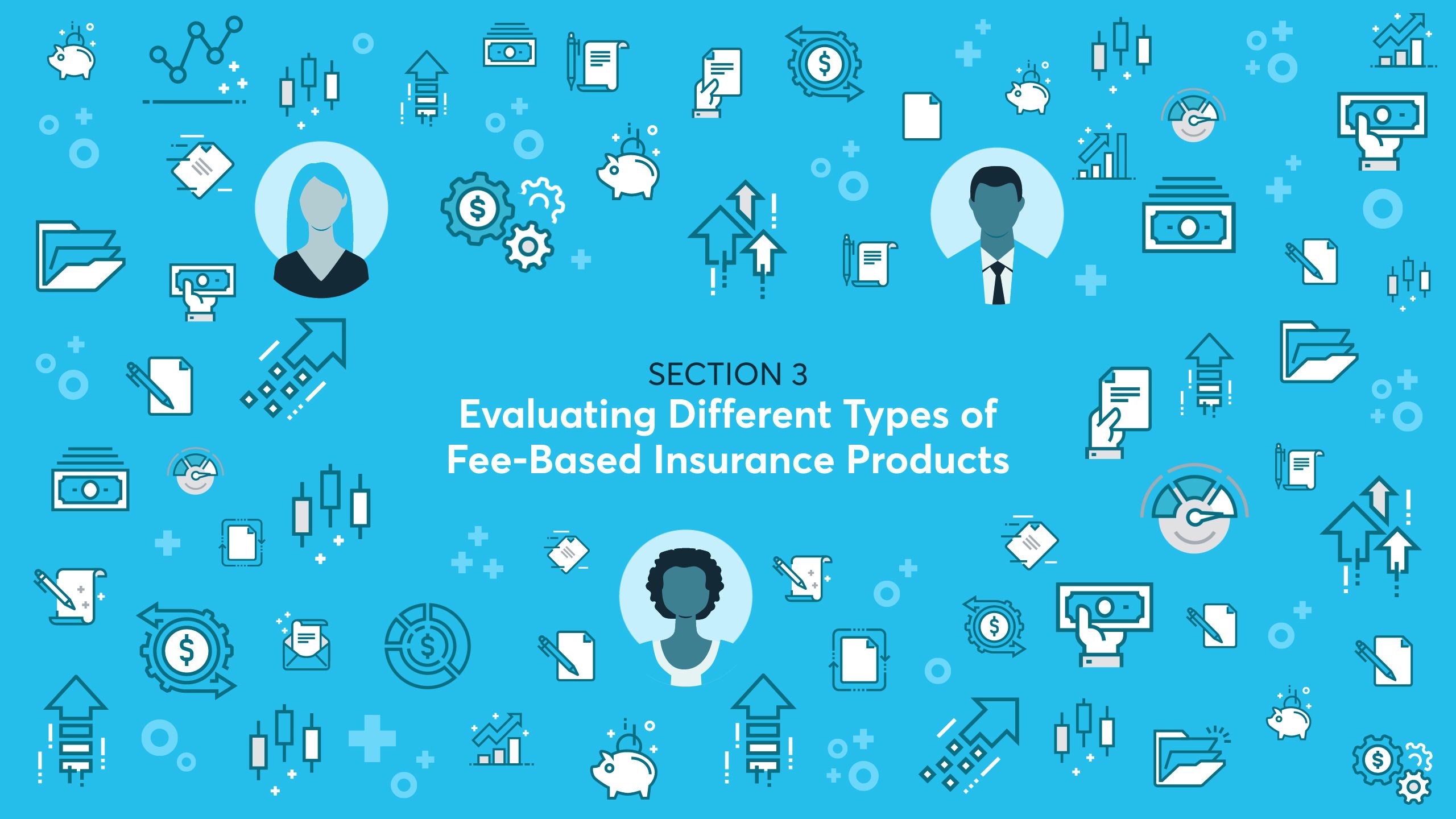
Currently, the changes that are allowing more RIAs and fee-based advisors to incorporate insurance products into clients’ plans are primarily related to annuities. These are long-term, tax-deferred investment vehicles with insurance guarantees that range from simple annuitization (carving up an initial investment into a series of periodic payments) to more complex features (such as living benefits and death benefits). These fee-based annuities help meet the unique needs of RIAs and fee-based advisors by eliminating commissions and cutting costs, while they also may provide more underlying funds and seamless tech integration, including greater portfolio management and fee-management capabilities.
For those independent RIAs and fee-based advisors who understand the value of insurance—but haven’t found the right solution that fits the way they work—this category of fee-based annuities is the breakthrough they’ve been waiting for. As the category of fee-based insurance continues to develop and more new types of products emerge, RIAs and fee-based advisors will have many more solutions to incorporate into clients’ plans at every stage of the financial lifecycle, depending on clients’ investing needs and priorities.

For clients focused on long-term tax-deferred accumulation, you can recommend annuities that offer different levels of growth potential and market exposure.
Variable Annuities (VAs)offer the opportunity for growth but with downside risk, because the contract value fluctuates based on the market’s ups and downs. Clients can offset some of the risk by buying riders that offer downside protection, such as Return of Premium (ROP) riders. Many VAs offer a range of Living Benefits, often to guarantee either a base amount of lifetime income or a guaranteed rate of withdrawal. (More details on Living Benefits appear below.)
Investment-Only Variable Annuities (IOVAs) are non-commissionable VAs that generally have lower costs and may offer more investment options than commissionable VAs. Since the goal of an IOVA is accumulation, these typically offer less in the way of an insurance guarantee.
Fixed Indexed Annuities (FIAs) provide an attractive rate of interest that is tied to equity indexes to help provide growth potential, as well as a floor to protect against downturns. FIAs include optional riders to generate guaranteed lifetime income. In recent years, many advisors have been recommending FIAs as an alternative to bonds.
Index Linked Annuities are tied to indexes such as the S&P 500® to allow for growth. While the upside is capped, these products also limit the downside risk. Index Linked Annuities sometimes include optional riders to ensure a guaranteed level of lifetime income.
Fixed Annuities (FAs) provide a guaranteed nominal rate of return regardless of what happens in the market, and can be converted into a guaranteed income stream. They’re a popular choice among clients whose risk tolerance is low.
Guaranteed Minimum Accumulation Benefits (GMAB) are optional riders which guarantee that, regardless of investment performance, a contract will be equal to a minimum percentage (usually 100%) of the initial amount invested after a specified number of years (typically 7-10 years).

Deferred Income Annuities (DIA)are contracts funded with non-qualified dollars, typically purchased around age 65 with the payout beginning at age 80 or 85.
Qualified Longevity Annuity Contracts (QLAC)are annuities funded with investments from qualified retirement plans such as 401(k)s, 403(b)s, and IRAs. They must be turned into lifetime income at a later time and are exempt from required minimum distribution rules for those turning age 70½.

Variable Universal Life (VUL)contracts build a cash value based on returns that are tied to market performance (the risk being that the value of the underlying investment can go down as well as up). VUL contracts can be used for supplemental retirement planning, business planning, long-term care, and education funding. The cost of insurance premiums is based on characteristics of the insured, including gender, health, and age.
Certain lifetime distributions (up to the amount of premiums paid) may be taken tax free. In addition, if the cash balance is sufficient, clients can take out tax-free loans. As long as they repay these loans with interest, the full death benefit remains intact. Owners must continue premium payments so their policies don’t lapse if the market goes down.
Generally, life insurance death benefits are not subject to federal income taxation.

Long-Term Care (LTC)contracts help older clients fund their future long-term care needs, whether living at home, in an assisted living facility, or in a nursing home. LTC is becoming essential, as Medicare only pays for a short stay in a nursing home or a specific amount of at-home care, under very strict conditions. In some cases, LTC can be linked to a universal life policy for greater financial protection and flexibility.

Immediate annuities, including single premium immediate annuities (SPIAs), begin payments soon after the purchaser makes an initial lump-sum investment. They may be best suited for individuals who are ready to retire or who already have retired.
Deferred annuities allow assets to grow tax-deferred, over years or decades, before they generate any income. As described above, the return may be variable, fixed or tied to a market index.
In many cases, living benefit riders may be purchased, for an additional fee. These living benefit riders typically provide guaranteed income, along with some upside potential.
Three popular types of guaranteed living benefit riders are described below.
- Guaranteed Minimum Income Benefit (GMIB) A GMIB guarantees a base amount of lifetime income regardless of how the investments perform. Minimum income payments are based on a pre-determined percentage (typically 4%-5%) of the initial amount invested after a specified holding period (typically 7-10 years).
- Guaranteed Minimum Withdrawal Benefit (GMWB) GMWBs guarantee that a certain percentage (typically 5-7%) of the initial amount invested can be withdrawn annually until the entire initial investment is completely recovered, regardless of market performance. If the underlying investment performs poorly, and the account value is depleted before the end of the withdrawal period, the investor can still continue to make withdrawals until the full amount of the original investment is recovered.
- Guaranteed Lifetime Withdrawal Benefit (GLWB)
GLWBs guarantee that a lifetime withdrawal percentage (typically 4-8%) of an established income benefit base can be withdrawn each year for life. The lifetime withdrawal percentage is determined at the time of the first withdrawal by different factors such as the annuitant’s or contract’s age. GLWBs often offer greater withdrawal amounts the longer the income stream is delayed and may include a step-up feature that would allow the potential for higher benefits in rising markets. With a GLWB, a client still has access to the annuity’s remaining cash value for greater liquidity.
| Client Need | Variable Annuity (VA) | Investment-Only Variable Annuity (IOVA) | Fixed Annuity (FA) | Fixed Indexed Annuity (FIA) | Single Premium Immediate Annuity (SPIA) | Deferred Income Annuity (DIA) | Qualified Longevity Annuity (QLAC) | Variable Universal Life Insurance (VUL) | Long-term Care Insurance (LTC) |
|---|---|---|---|---|---|---|---|---|---|
| Tax-Deferred Accumulation | ✔ | ✔ | ✔ | ✔ | ✔ | ✔ | ✔ | ✔ | |
| Retirement Income | ✔ | ✔ | ✔ | ✔ | ✔ | ✔ | ✔ | ✔ | |
| Legacy Planning | ✔ | ✔ | ✔ | ✔ | ✔ | ✔ | ✔ | ||
| Tax Advantages | ✔ | ✔ | ✔ | ✔ | ✔ | ✔ | ✔ | ✔ | |
| Unlimited Contributions | ✔ | ✔ | ✔ | ✔ | ✔ | ✔ | ✔ | ✔ | |
| Market Participation | ✔ | ✔ | ✔ | ✔ | ✔ | ||||
| Downside Protection | ✔
(potential) |
✔ | ✔
(if fixed) |
✔
(if fixed) |
|||||
| Access to Assets | ✔ | ✔ | ✔ | ✔ | ✔ | ✔ | |||
| Enhanced Living Benefits | ✔ | ✔ | |||||||
| Enhanced Death Benefit | ✔ | ✔ | ✔ | ✔ | ✔ | ||||
| Longevity Risk | ✔ | ✔ | ✔ | ✔ |

For RIAs and fee-based advisors, integrating insurance and annuity products into their practice can help them create a more holistic approach to financial planning for their clients. In a scenario where everything is aggregated in one place, the insurance holdings become part of a total portfolio, with a variety of assets, both taxable and tax-deferred, that can be managed holistically to the client’s advantage. But when invested in traditional insurance products, these are “held away” assets from the advisor’s perspective.
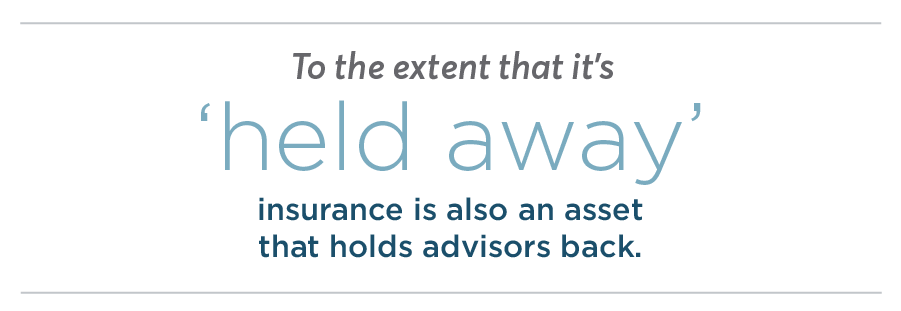
Fee-based insurance products allow RIAs and fee-based advisors to bring these assets under their own management. In addition to attracting additional AUM, fee-based insurance and annuity products that offer data feeds and integration capabilities with the custodial platforms and portfolio management systems used by independent RIAs and fee-based advisors can simplify the advisor’s job—and create a more optimal experience for the client.
This is not to say there will never be a need for outside experts. At any given time, CPAs, tax planners, estate attorneys, and eldercare experts will all have valuable contributions to make. Still, the more an advisor can offer comprehensive holistic planning with specialized services in-house, the more control he or she will have over the quality of the client experience.
There is even a mechanism called a 1035 exchange which doesn’t trigger any tax obligations and which advisors may be able to use to transition clients from a traditional insurance product into a newer fee-based insurance or annuity product. Before suggesting this, however, advisors should look into the loss of any benefits or guarantees that might result from such an exchange.
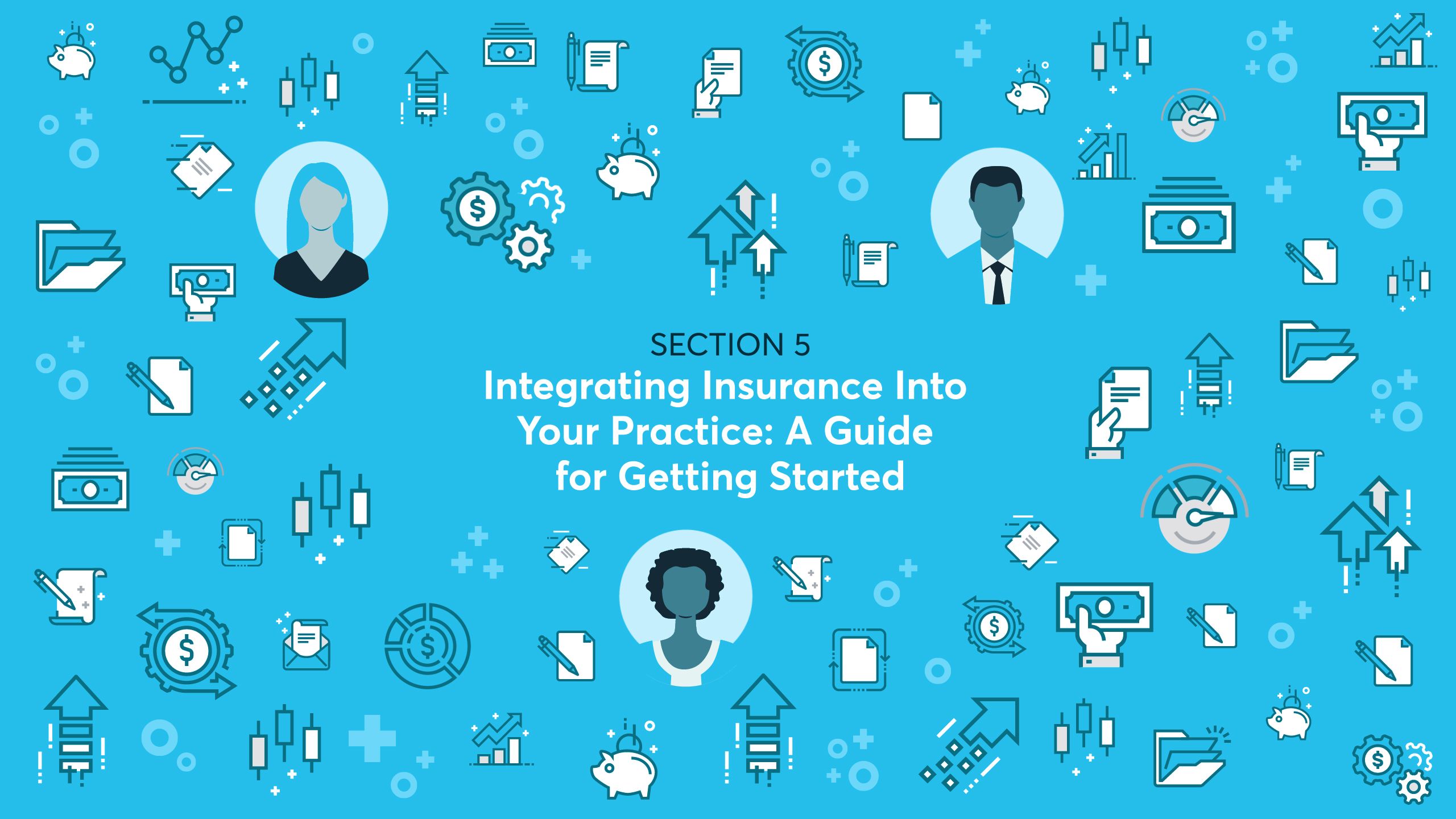
There are many factors that RIAs and fee-based advisors should consider when integrating insurance into their practices, including where to get the insurance and which experts to consult. In addition, there are practical issues relating to licensing, compensation, fee management, and disclosure. All of these are discussed below.

Some RIAs and fee-based advisors can get insurance products without going outside of their organizations. If an advisor is affiliated with a large broker-dealer, the broker-dealer may have a mechanism (whether a standalone insurance division or a home-office service) for evaluating insurance providers and may offer a list of approved products.
For advisors who don’t have this option, going directly to a product manufacturer—that is, to an insurance company itself—may be the way to go. Some product manufacturers now have specialized teams to meet the unique needs of RIAs and fee-based advisors. These manufacturers typically use a more consultative sales approach to help advisors identify and implement insurance solutions.
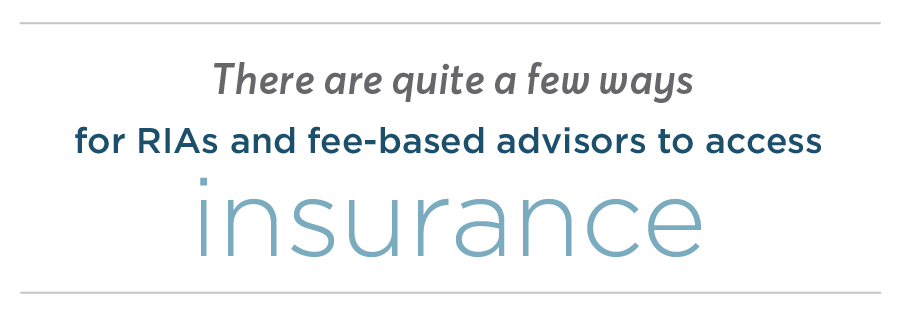
Insurance agents and brokers are another source of products and advice. Captive agents (those who only work with a single insurance company) offer products from their own company only. Independent insurance agents, representing multiple companies, offer more choices.
Insurance can also be purchased through a so-called independent marketing organization (IMO) or brokerage general agency (BGA). These are intermediary organizations that have relationships with multiple insurance companies and that have already pre-vetted many insurance products, simplifying the task for advisors. Their middleman status can add some cost to transactions.
Finally, there are fee-only insurance advisors. Different from insurance agents, these financial experts don’t actually sell insurance; instead, they provide comprehensive advice. Will a client benefit from having insurance? If so, which type of insurance should she consider? Which insurers are best to work with? Insurance advisors typically charge a flat fee for answering such questions and for providing consultations and advice.
Licensing and Other Knotty Issues

Many RIAs and fee-based advisors don’t hold an insurance license and can’t sell insurance. This is a problem they can solve by establishing a relationship with an insurance company that would provide a licensed insurance agent service directly to RIAs and fee-based advisors at no additional cost.
Partnering directly with such an insurer instead of simply referring the client to an outside insurance expert means the advisor can continue to maintain the relationship with the client and oversee all aspects of the client experience. It also reduces the risk that the outside insurance expert will in some way come between the advisor the client.

For many RIAs and fee-based advisors, offering insurance products raises the question of how to charge an advisory fee for insurance products that are not securities. Some advisors may even wonder if the Securities and Exchange Commission (SEC) allows this. Our interpretation of SEC guidelines suggests they do, though RIAs should consult with their own attorneys regarding fees that may be charged to clients for insurance-related products.
In any case, a few guidelines should be kept in mind. First, compensation must be reasonably related to the services provided. The time and effort required for managing many long-term, illiquid insurance products may be lower than that required for the liquid portion of a client’s portfolio. In addition, more work is typically involved for an IOVA than for a fixed annuity and for managing an accumulation product that doesn’t generate any income for years than for a product that generates income immediately. That said, comprehensive holistic planning and advising can be more involved than investment management and can justify a fee. Even in the income phase, a client will have choices to make with respect to income options, and an advisor should be able to charge for any advice provided.
In principle, insurance products can be part of holistic fee arrangements—part of a single fee that the RIA charges for a broad set of services. How an advisor bills for other non-managed products is certainly an important consideration. The bottom line is that the part of the fee tied to insurance must be justifiable given the work performed.

With products that have an accumulated cash value—such as fee-based variable annuities and IOVAs—an advisory fee can be drawn directly from the asset in the policy. This is easiest in situations where the fee-based product is integrated into the advisor’s workstation or technology platform. In these cases, an agreement must be in place between the advisor and the client. There are things to be careful about such as pulling the fees directly from non-qualified tax-deferred vehicles. Payments from such contracts will trigger a tax liability and, for clients under the age of 59 ½, could result in an additional 10% tax penalty.
With other annuity products, pulling the fee directly from the asset may not be possible. With a SPIA, for instance, a better option would usually be to deduct the advisory fee from the income stream generated by the product.
Other options are to aggregate all advisory fees and pull them from a single client asset—such as a sweep account or money market fund—or bill the client directly.
However, if the advisor decides to collect the fee, it’s worth remembering that some approaches have tax consequences. Therefore, it’s best to consult with a tax specialist and understand the options provided by the insurer before settling on an approach with clients.

Transparency around compensation is fundamental to a fiduciary standard. Fees (and any additional compensation earned) must be fully disclosed. Likewise, if any conflicts of interest exist, they must be communicated. This includes situations where an RIA or fee-based advisor might have an ownership stake in a licensed insurance agency. Offering clients a product from the agency, if the advisor has an ownership stake or receives a commission, creates a conflict of interest. Advisors who are in such a position should think carefully about how and whether they want to do this.

• Not a deposit • Not FDIC or NCUSIF insured • Not guaranteed by the institution • Not insured by any federal government agency • May lose value
i Defined as those advisors with personal annual income of more than $500,000 or who individually manage a total AUM of $250 million or more.
iWithdrawals made prior to age 59½ may incur a 10% IRS tax penalty. iii Withdrawals made prior to age 59½ may incur a 10% IRS tax penalty.
iv Stretching may be appropriate for beneficiaries who do not have immediate need of the assets. As with all securities, there are risks associated with stretching, such as changes to tax laws and the impact of inflation.
v This assumes that the life insurance policy is not a modified endowment contract.
vi Not available in Utah
Nationwide, Nationwide is on your side, the Nationwide N and Eagle are service marks of Nationwide Mutual Insurance Company. © 2018
Jefferson National Life Insurance Company | Jefferson National Life Insurance Company of New York
10350 Ormsby Park Place | Louisville, Kentucky 40223 | 866-667-0564
ASN-0149AO (12/18)
FOR FINANCIAL PROFESSIONAL USE ONLY. NOT FOR PUBLIC USE.


|




